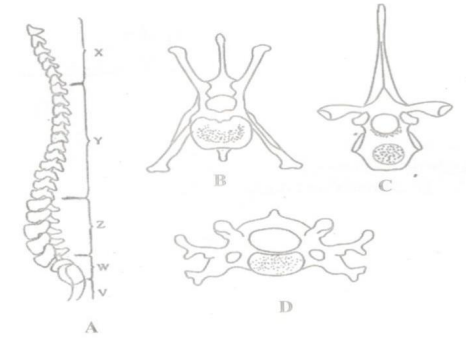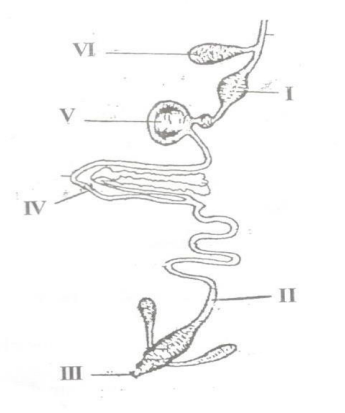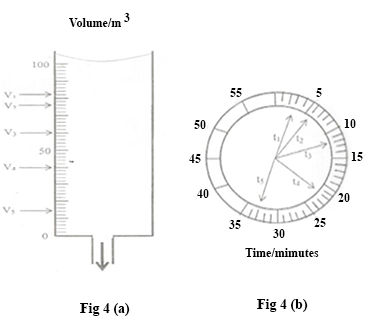1.
The component of white light which is most deviated when light is dispersed is
blue
red
violet
yellow
2.
Which of the following characters in human is sex - linked ?
Baldness
Skin colour
Eye colour
Sickle cell
3.
An example of an abiotic factor in an ecosytem is
altitude
grazing
predation
shading
4.
Alkanoic acid contain
carbon atoms and hydrogen atoms only
carbon atom and oxygen atoms only
carbon atoms, hydrogen atom and oxygen atoms only
carbon atoms, hydrogen atoms and nitrogen atoms only
5.
Which of the following mineral is not needed by crop in large quantities ?
Calcium
Iron
Nitrogen
Phosphorus
6.
A rigid bar that is supported at a point which turning occurs is
lever.
pulley.
wheel and axle.
inclined plane.
7.
One criterion used in the classification of domestic rabbit is the
age.
eye colour.
height.
size.
8.
Which of the following chemical is toxic ?
Potassium cyanide
Sodium hydroxide
Hydrogen peroxide
Calcium oxide
9.
The unit of heredity found in the chromosomes is
centriole
deoxyribonucleic acid
mitochondrion
endoplasmic reticulum
10.
Which of the following element is constituent of brass?
Iron
Magnesium
Tin
Zinc
11.
The process in the hydrological cycle which results in water vapour condensing and fallimg on the earth surface is
evaporation
infiltration
precipitation
sublimation
12.
The centre of gravity of a body is
always at its centre
a point where its total mass is always concentrated
always at its end
a point where it can be supported to be in equilibrium
13.
Which of the following crops is not a root vegetable?
Carrot
Ginger
Lettuce
Onion
14.
The aim of the ring experiment in the a flowering plant is to demonstrate that
water is transported by the phloem
food substances are transported by the phloem
food substances are formed in the stem
water is excreted from the stem
15.
Which of the following properties is associated with ionic compound?
are soluble in organic solvent
conduct electricity in the molten state
have low melting and boiling point
consists of molecules
16.
The sedimentary rock is also referred to as
stratified rock
slated rock
silical rock
separated rock
17.
One similarity of arteries and capillaries is that both have
permeable walls
muscular walls
no valves
large lumens
18.
Which of the following instruments is most suitable for measuring the thickness of razor blade?
Metre rule
Micrometer screw gauge
Vernier callipers
Surveyor's tape
19.
The chemical which is most likely to have highly inflammable hazard symbol in its container is on
ethanol
mercury
ammonium hydroxide
sodium hydroxide
20.
The part of the maize grain which grows into the shoot is the
cotyledon
endosperm
plumule
radicle
21.
An effort of 120N was used to overcome a load of 80N.What is the mechanical advantage of te system?
0.67
1.50
40.00
200.00
22.
Which of the flowering reactions can produce salt and water only?
NaOH(aq)+ CH3C00H(aq)
NaOH(aq) + NH3(aq)
NH3(aq) + H2O(l)
NaCl(aq) + AgNO3(aq)
23.
The best way of harvesting hot pepper is by
shaking the plant
handpicking the fruits
allowing the fruits to drop naturally
cutting the fruit with a sharp knife
24.
The area of occupied by a box placed on a table is 2.0 m2. If the box exerts a pressure of 50 Pa 0n the table, calculate the mass of the box.
[g= 10m-2]
2.5 kg
10.0 kg
100.0 kg
1000.0 kg
25.
Which of the following substances would have a pH below 7?
Pure water
Milk of magnesia
Wood ash
Lemon juice
26.
Consider the food chain below and use it to answer question 26.
Grass → Earthworm → Frog → Hawk
Which of the organisms is the primary consumer?
Earthworm
Frog
Grass
Hawk
27.
Consider the food chain below and use it to answer question below.
Grass → Earthworm → Frog → Hawk
The organism which contains the least energy is
Earthworm.
Frog.
Grass.
Hawk.
28.
In cattle, anaemia, damaged skin and heart-water disease are caused by...
liver-fluke
roundworm
tapeworm
tick
29.
In a simple machine, the force that overcomes the resistance is
effort
effort
load
pivot
30.
A molar solution of KHSO4 contains
[K = 39, H = 1, S = 32, O = 16]
80g 0f KHSO4 in 1dm3 of solution
100g of KHSO4 in 100cm3 of solution
120g of KHSO4 in 100cm3 of solution
136g of KHSO4 in 1dm3 of solution
31.
Which of the following functions are associated with mammalian skeleton? It...
I. stores calcium and phosphates.
II. protects vial internal organs.
III. produce red blood cells.
IV. stores proteins.
I and II only
III and IV only
I, II, and III only
II, III and IV only
32.
The most appropriate time to transplant vegetable seedling is
dawn
midday
sunrise
sunset
33.
Rainbow formation is a practical illustration of the light phenomenon known as
dispersion
interference
mirage
reflection
34.
An example of a metalloid is
magnesium
potassium
phosphorus
silicon
35.
Which of the following statements about animals are correct?
I. Movement is quick and visible
II. Chloroplast is absent
III. They have thick cellulose cell wall
I and II only
I and III only
II and III only
I, II and III
36.
The main reason for trimming the side of a vegetable bed is to control
run-off water
leaching of nutrient
breaking of bed
soil erosion
37.
Which of the following observation is a direct consequence of thermal expansion?
I. Cracks in concrete slaps
II. Sagging of electric cable
III. Buckling of railway line
IV. Crackling noise from roofing sheets
I and II only
I,II and IV only
II, III and IV only
I, II, III and IV
38.
A solution of volume 500 cm3 contains 9.80 g 0f H2SO4.
Determine its molar concentration.
[S=32, O=16, H=1]
0.10 M
0.20 M
0.40 M
0.50 M
39.
A ball and socket joint in the human body does not allow circular
circular movement
side to side movement
up and down movement
gliding movement
40.
The way of controlling endoparasites in cattle is through
rotational grazing
early morning grazing
dipping the animals
spraying the animals with recommended pesticides
41.
An electrical circuit consists of a 2 V cell connected to a 5 Ω resistor.
Determine the amount of current through the resistor when the circuit is closed.
0.4 A
1.0 A
2.5 A
4.0 A
42.
Which of the following hydrocarbons is an alkyne?
C2H2
C2H4
C3H6
C3H8
43.
An example of multicellular organism is
Amoeba
Euglena
Paramecium
Rhizopus
44.
Farmers prefer to grow crops on loamy soils because loamy soils
I. usually contains large amountof plant nutrient
II. protect the crops from injury
III. have equal amounts of clay and sand
IV. hold plants firmly
Which of the statements above is/are correct?
I only
I and II only
I and III only
I and IV only
45.
A precaution that has to be taken when using a liquid-in-glass thermoter is
holding the bulb in hand when is use
taking the readings quickly before thermal equilibrium is attained
ensuring that the bulb is fully immersed in the surface
ensuring that the bulb touches the vessel containing the surface
46.
Soap may itch the skin when it contains excess
acid
alkali
fat
glycerol
47.
The gas in the atmosphere that absorbs ultra violet rays is
carbon(IV) oxide
nitrogen
oxygen
ozone
48.
A soil considered fertile when it
contains a lots of living organism
is highly aerated
has high water retention ability
can support adequate crop yield
49.
The energy possessed by a student on top of a building is
chemical energy
heat energy
kinetic energy
potential energy
50.
Which of the following statements about water is correct? It turns blue anhydrous cobalt
green
red
white
yellow
(a)
(i)
What is meant by the term modern technology?
(ii)
Give three reasons for the lack of improvement of technology in Ghana?
(b)
(i)
Explain the term convection as used in heat energy.
(ii)
Explain why convection cannot take place in solids.
(c)
(i)
Differentiate between soil erosion and soil depletion.
(ii)
Give three effects of soil erosion on agricultural productivity.
(d)
(i)
List three causes of indigestion in humans.
(ii)
State two ways of preventing tooth decay.
(a)
A man with normal red blood cells is married to a woman who is a sickle cell carrier. With the aid of a genetic diagram, explain the genetic constitution of their children.
(b)
(i)
Explain the term sublimation.
(ii)
Name three substances that can sublime.
(c)
Two lamps, each of resistance 3 Ω, are connected in parallel. The arrangement is then connected across a 4.5 V battery.
(i)
Draw a circuit diagram for the arrangement.
(ii)
Calculate the effective resistance of the lamps.
(iii)
Calculate the total current in the circuit.
(d)
(i)
Distinguish between green manure and farmyard manure.
(ii)
State three ways in which organic fertilizers are important to the soil.
(a)
(i)
Explain the term identification as used in animal production.
(ii)
Describe two methods of identifying farm animals.
(b)
(i)
What is a reflex action?
(ii)
Distinguish between excretion and egestion.
(c)
(i)
List two groups of hydrocarbons.
(ii)
A group of hydrocarbons has the general formula CnH2n.
α)
Name the first two members of the group.
β)
State the main reaction that members of this group undergo.
(d)
State the class of lever to which each of the following simple machines belongs:
(i)
broom;
(ii)
claw hammer;
(iii)
fishing rod;
(iv)
secateurs;
(v)
bottle top opener.
(a)
(i)
Define the term pressure.
(ii)
A regular concrete block weighing 5 kg, has dimensions 8 cm x 20 cm x 50 cm.
Calculate the greatest possible pressure the block will exert on the ground.
[g = 10 m s-2]
(b)
(i)
Give three reasons why poultry farms should be distanced from residential areas.
(ii)
Mention two methods of preserving poultry eggs.
(c)
State two causes each of the following problems associated with reproduction in humans:
(i)
ectopic pregnancy;
(ii)
infertility in men.
(d)
Indicate whether each of the following substances is an element, a compound or a mixture:
(i)
water;
(ii)
iron filings;
(iii)
glass;
(iv)
milk of magnesia;
(v)
iodine crystals.
(a)
A 0.04 g of copper metal reacts completely with 25 cm3 of 0.5 mol dm-3 H2SO4.
(i)
Write a balanced chemical equation for the reaction.
(ii)
Calculate the molar mass of the copper metal.
(b)
(i)
Give two functions of the human ear.
(ii)
Arrange the following media in order of increasing speed of sound in each of them: solids, liquids and gases.
(c)
(i)
Give two advantages of clayey soil over sandy soil.
(ii)
State three symptoms of nitrogen deficiency in maize.
(d)
State four ways in which biotic factors are useful in an ecosystem.
(a)
(i)
State three ways through which AIDS is transmitted.
(ii)
List three effects of drug abuse on the user.
(b)
Name four endocrine glands found in humans.
(c)
(i)
What is a shadow?
(ii)
Draw a ray diagram to illustrate a ray of light travelling from glass to air.
(d)
(i)
Explain the term artificial insemination as used in animal production.
(ii)
State three advantages of artificial insemination in animal production.
Fig. 1 illustrates four different bones, labelled A, B, C, D found in the human body.
Study the illustrations carefully and answer the questions that follow.

Fig. 1
(a)
Identify each of the bones labeled A, B, C and D.
(b)
Name the part of the skeletal system to which the bone labeled A belongs.
(c)
Name each of the parts labeled X, Y, Z, W and V.
(d)
Count and record the number of bones in each of the parts labeled X, Y, Z, W and V.
Fig. 2 below is an illustration of the pH values X1, X2, X3, X4 and X5 of five different solutions on a pH scale.
The solutions are vinegar, distilled water, solution of plant ashes, dilute nitric acid and ammonia solution (not listed in any order).
Study the illustrations carefully and answer the questions that follow.

Fig. 2
(a)
Read and record each of the pH values X1, X2, X3, X4 and X5.
(b)
Pair each of the pH values with the appropriate solution.
(c)
Tabulate your data as shown below.
| pH | X1 | X2 | X3 | X4 | X5 |
| Solution |
(d)
Give one reason for each pair of pH value and solution.
Fig. 3 below illustrates the digestive system of a farm animal.
Study the illustration carefully and answer the questions that follow.

Fig. 3
(a)
Identify the digestive system.
(b)
Name each of the parts labeled I, II, III, IV, V and VI.
(c)
State one function of each of the parts labeled I, II, III, IV, V and VI.
(d)
State two features of the part labeled V that help in the performance of the function stated in (c).
In an experiment to investigate the rate at which water is discharged from a container, the volume V of water left in the container after a period of time t is measured. Fig. 4(a) and Fig. 4(b) illustrate the volume V = V1, V2, V3, V4 and V5 and the corresponding time t1, t2, t3, t4, and t5 respectively.
Study the illustrations carefully and answer the questions that follow.

(a)
Measure and record the volume V = V1, V2, V3, V4 and V5.
(b)
Read and record the time t = t1, t2, t3, t4, and t5.
(c)
Tabulate your results as shown as below.
| Volume V/m3 | V1 = | V2 = | V3 = | V4 = | V5 = |
| Time t/minutes | t1= | t2= | t3= | t4= | t5= |
(d)
Plot a graph with V on the vertical axis and t on the horizontal axis.
(e)
Determine the slope, s, of the slope.
(f)
Determine the intercept on the
(i)
vertical axis.
(ii)
horizontal axis.